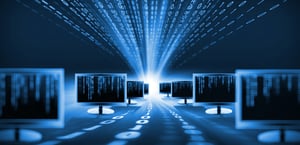Virtual desktops have revolutionized the way businesses operate, offering transformative benefits in productivity, security, and cost efficiency. To understand them better, we are creating 2 blogs on the topic of Virtual Desktops. Today, we ask:
What is a Virtual Desktop?
A virtual desktop allows employees access to their work computers remotely. The operating system and personal data are stored on a network that can be located anywhere using unique log-in credentials, instead of locally on the PC itself or other computing devices. A desktop or laptop is standard, but if you are looking for the added convenience of browsing your work desktop with a tablet, smartphone, or another device that can connect to the Internet, that is a possibility as well.
There are multiple ways to set up a virtual desktop. A standard computer is best run through a Desktop as a Service (DaaS) to host the online server. More portable hardware such as an iOS, Android, or Chromebook can benefit from Cloud-based virtual desktops. Using many different operating systems such as Windows, Linus, iOS, and Android can optimize a workstation for a complicated task.
Each system provides different advantages and purposes but changing between many different operating systems requires jumping through some hoops. Doing so lowers productivity by having to cross these barriers each time an employee wants to switch devices to perform a specific task. With a virtual desktop infrastructure (VDI), simply choose your favorite device and get down to business.
The virtual desktop behaves just as a traditional desktop would. Your programs, history, and personalization settings stay intact and appear just as you left them at the end of the workday. These aspects include wallpapers, widgets, and everything that you are familiar with on your work computer. When you are finished working on a project, just save as you normally would, and the files will be kept in a folder within the virtual server and are accessible whether you are in-office or remote.
Remote servers use software called a hypervisor to simulate the user's desktop. This technology enables the server to run many instances of the same operating system, so it’s perfect for quickly sharing work between multiple devices or a workplace setting with many different users coming and going from the office. The hypervisor stores the system’s memory, processor, and other vital aspects of the operating system, juggling all the different users with ease.
Tomorrow, we will share 3 Advantages of Switching to a Virtual Desktop.
If you are looking to make the switch to virtual systems but are not sure where to being or are not getting the guidance you need, contact PCS today. We offer a Free 30-minute Technology Consultation to help your business implement a safer technology solution.

